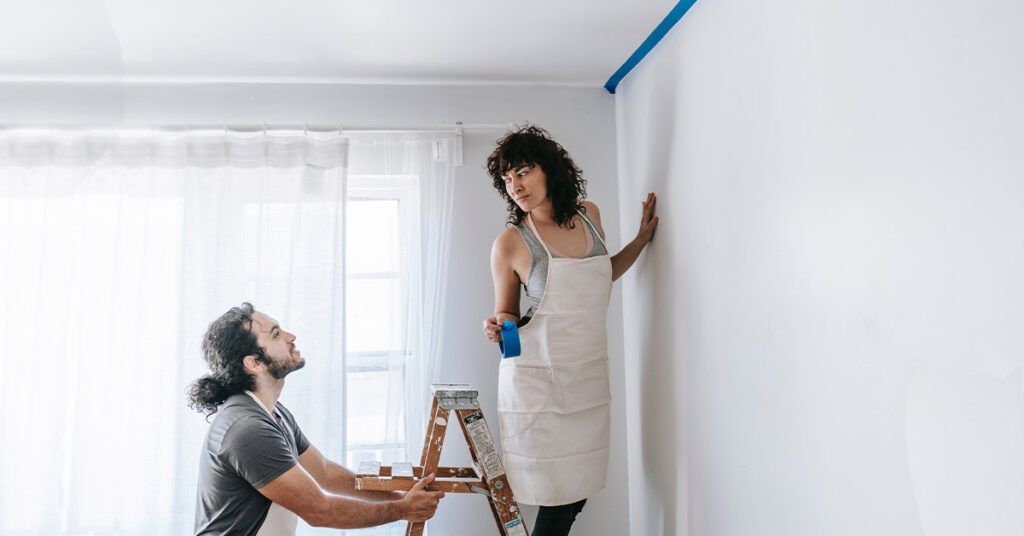
Are you trying to decide whether to attempt a DIY tile installation or hire a professional tile installer? Sometimes, a DIY project can be a fun way to expand your skills and save some money. Unfortunately, we hear stories all the time about people who got in over their heads when it comes to tile installation. Before you attempt DIY tile, make sure your decision is based on realistic expectations. The details in this article will help you understand what to expect.
The Scope of the Project
The first thing you’ll want to do is define the project goals. Then, make a list of important factors related to accomplishing the work, including materials, tools, and equipment.
- Permits. Your jurisdiction may require a permit and inspections for your project.
- Construction documents. Also known as “blueprints,” construction documents may be required by law for remodeling. Check with your city or county authorities.
- Dumpster. Easily dispose of construction debris, appliances, cabinets, and the like with a dumpster. You may need to get permission from the city or your homeowners’ association.
- Subfloor repair. Suppose you are replacing existing tile with new tile because the existing tile is failing. You may experience the exact same issues with your brand-new tile if there are problems with your subfloor.
- Subcontractors. If you are knocking down a wall or changing the layout of a room, you may need to hire an electrician or plumber for your project.
- Accessibility. Moving materials and equipment may be challenging if you have gates, elevated entrances, or otherwise restricted pathways. You’ll want to think this through ahead of time.
- Upgrades. Heated flooring, niches, benches, and other tile upgrades will add to the complexity of your project. Anyone without knowledge and experience should expect a steep learning curve. A significant amount of effort and time will be needed to achieve proficiency.
- Warranties. Poor installation workmanship will void warranties.
Depending on the scope of your project, your list of considerations may be rather lengthy. Before you move furniture or purchase tile, work out all these details.
Your Schedule
Do you have time for a DIY tile project? Consider how your DIY project will align with work, family commitments, and your social life. An unfinished project will create a temporary sense of disorder in your home, especially if the project is in a highly trafficked area. If you can only work on weekends, it may be weeks or even months of inconvenience.
The more complex a project is, the longer it will take. If you’re new to tile installation, you will need to consider the learning curve. Do research, watch videos, and read the manufacturer’s instructions, etc. before you dive into your project, rather than learning as you go. Homeowners often change their minds about DIY tile projects when they discover how much time they will need to invest in education.
How far do you live from suppliers? You’ll want to take your drive time into account.
If your project requires assistance from others, you will need to consider their schedules, as well.
Are you expecting a baby? Are you expecting company? Are you putting your house on the market? You may want to either delay your DIY project or hire a tile installation contractor. Rushing through your project could result in a dissatisfactory outcome.
Expenses
Materials, tools and equipment, and miscellaneous costs should be calculated before you attempt a DIY tile project. Homeowners are pretty good at crunching numbers when it comes to materials and tools, but not so good at anticipating those miscellaneous expenses. Clients often hire us after realizing that it would be more cost-effective to hire a pro than it would be to install the tile themselves.
- Materials. When you purchase tile, get plenty of extra tiles for waste, as well as replacement tiles in case of damage down the road. Other materials include adhesives, mortars, grout, backer board, primer, tile spacers, transition strips, caulk, etc. Materials will vary from one project to the next. Don’t forget plastic, drop cloths, and tape to protect surrounding surfaces.
- Tools and equipment. You’ll need to purchase or rent either a wet saw or a score-and-snap tile cutter. Other tools include trowels, a level, grout float, measuring tape, mixing equipment, buckets, sponges, safety gear, etc. Like materials, the list of tools needed for a project will vary from one project to the next.
- Miscellaneous expenses. If you live far away from suppliers, your fuel costs will increase. Other miscellaneous expenses include labor costs (if you are hiring someone to help) and project-specific extras like custom grout colors or specialized equipment. In construction work, there are always unexpected expenses. Count on it. Since you do not install tile every day, you can also count on expenses associated with mistakes.
The greatest and most underestimated expense of all is the income loss associated with your labor time. Here’s how to estimate this expense. First, determine your hourly earnings. Then, estimate the project time. Multiply these two numbers to determine your income loss. If you compare the amount of your income loss to bids from professional tile installation contractors, you can determine how much money you actually save by doing the project labor yourself.
Here’s an example. Suppose you earn $50/hour at work. You are planning a relatively uncomplicated accent wall tile project. You estimate that it will take you 20 hours to research and educate yourself, read the manufacturers’ instructions, determine the scope of your project, and do any other planning. With a few trips to various suppliers, it will take you about 8 hours to get the materials and tools. You’ll take approximately 2 hours to prep your work area, including masking and protecting the surrounding surfaces. You’ll do the installation for 10 hours each weekend for 2 weekends, working about 20 hours total. It will take you 2 hours to clean up afterward.
That is a total of 52 hours. Your income loss would be $2,600. If a professional’s quote for labor time is $4,000. You’ll save about $1,400. This is assuming that everything goes according to plan with no mistakes.
NOTE: This example does not factor in the cost of materials, tools and equipment, and miscellaneous expenses.
Comfort and Safety
Consider the potential physical challenges and risks involved with DIY tile installation. Equipment and materials can be heavy, bulky, and awkward. People who are not used to lifting, pushing, pulling, and working with sharp edges are more prone to strains, sprains, or accidents. A project that may seem manageable in theory can turn out to be a real challenge for anyone lacking the muscle memory or fine motor skills that years of experience bring.
The rough-and-tumble realities of the tile installation process are often overlooked by DIY enthusiasts. For your comfort and safety, make sure you are physically able to do the work before you start a DIY tile installation. Wear the appropriate safety gear for tile installation activities, as needed, including eye protection, dust mask, earplugs, gloves, sturdy footwear, and appropriate clothing. Set up proper ventilation in your work area and follow the manufacturer’s safety instructions. Visit Occupational Safety and Health Administration (OSHA) for more specific safety information for your project.
When comparing a DIY project with hiring a professional, remember to factor in the scope of the project, your schedule, expenses, and your safety and comfort. Is DIY worth it? We won’t answer that question for you, but we will be happy to answer any questions you may have about our tile installation services.

